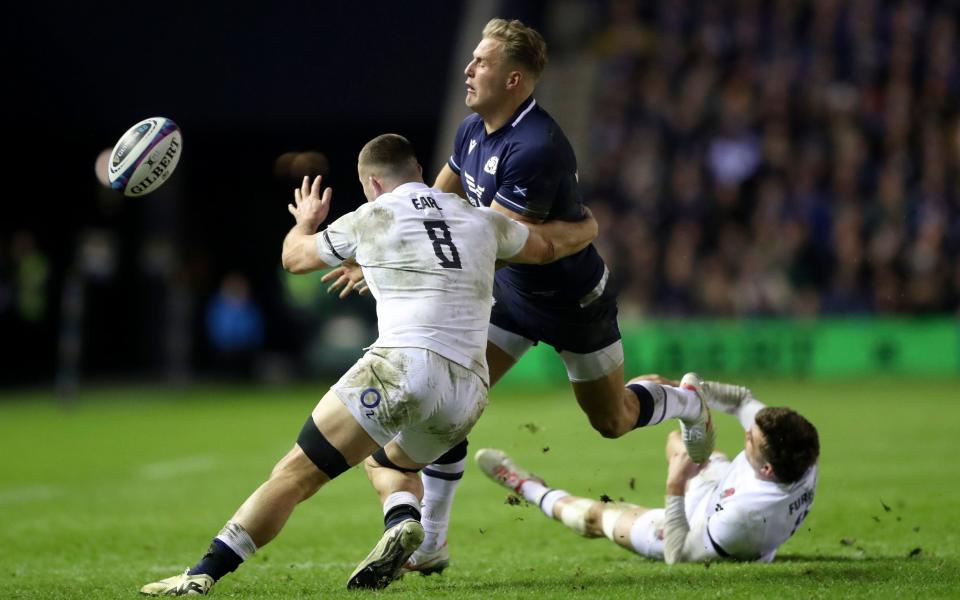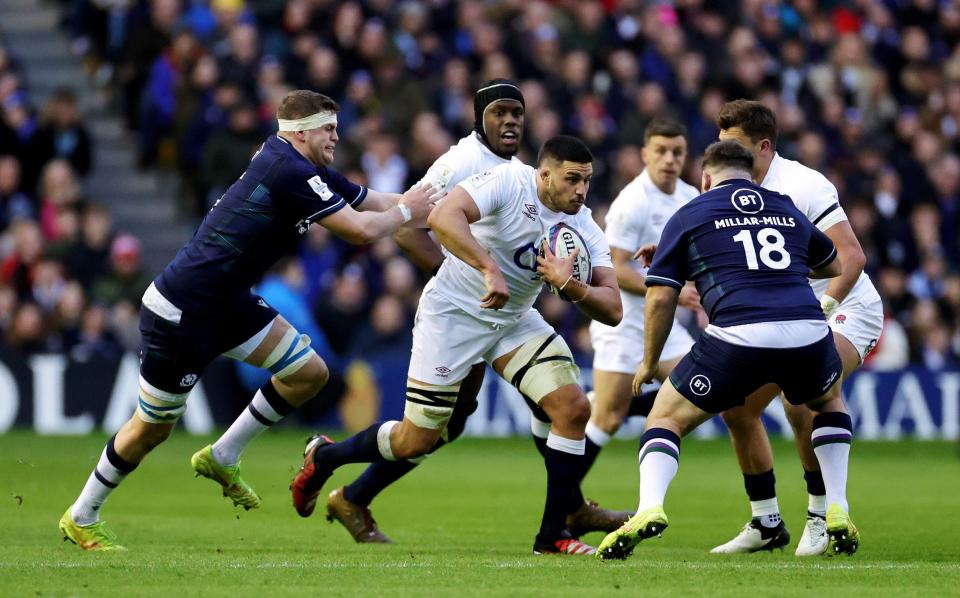England are producing talented No 8s – should Steve Borthwick turn to one as a ball-carrier?

One of the moments that most jarringly signalled England’s inferiority at Murrayfield arrived in the 70th minute with Scotland leading 30-21. Ollie Lawrence had darted into midfield from a line-out and Maro Itoje ambled around the ensuing ruck. Ben Spencer lifted a pass and the lock headed towards contact without much support. There, he was wrapped up by Jack Dempsey and Ewan Ashman.
George Martin and Chandler Cunningham-South muscled in, but could not rescue another shapeless and uncertain foray. Andrew Brace proclaimed a maul and Scotland earned a turnover. In the process, Dempsey and Ashman drove another nail into the coffin of England’s attacking performance. Blighted by handling errors, the visitors were not intricate enough to consistently outmanoeuvre Scotland after the early strike move that yielded George Furbank’s try. Nor, crucially, could they fall back on power to break down the door.
Ben Earl did his utmost and returned 48 metres from 16 carries, using his footwork and deceptive strength to battle beyond the gain-line. Opposite a balanced and disruptive Scotland pack, though, it caused one to wonder whether a different No 8 might have suited England better. There are certainly options available, with Alex Dombrandt in the wider squad and Zach Mercer fit yet overlooked. Alfie Barbeary started for England A in the East Midlands and Tom Willis has admirable assets.
Steve Borthwick has not needed to say it out loud. Certain selections over the past year have heavily implied his concern that England lack gnarly, nasty ball-carriers. First there was the reintegration of Billy Vunipola for the World Cup, which always seemed more out of hope than expectation. Unsurprisingly, after the Saracen’s summer was compromised by injury and then suspension, he was underwhelming at the tournament. One wonders whether Borthwick regrets persevering with Vunipola as a replacement for the semi-final against South Africa, rather than instating Lewis Ludlam as back-row cover. The former committed costly errors.
Earl shifted to the base of the scrum at the World Cup and was England’s shining light, but Borthwick has fast-tracked henchmen to help in heavy traffic this Six Nations. Ethan Roots and Cunningham-South were whisked out of left-field for debuts in a bid to remedy a deficit of thrust. England’s head coach is acutely aware that supporters have heard enough excuses, but this is effectively a third new beginning in three campaigns, given the number of World Cup regulars – Courtney Lawes, Owen Farrell, Joe Marchant especially – that are now unavailable and the tactical changes being undertaken. Following the win over Italy in Rome three weeks ago, Borthwick did lay down some further context.
“If you look at the power that England had, England haven’t produced that kind of power for a little while,” he said. “We are trying to find a way and develop a way that allows us to play to the strengths that we do have. This group has speed. It has a different type of athleticism. It might not have the same levels of power but it has ball movement. We are trying to find that balance.”
The suggestion here is that England are still adapting to life with the Vunipola brothers and Manu Tuilagi past their peak. Eddie Jones supplemented those three with Nathan Hughes and Ben Te’o. Billy Vunipola’s best probably remains underappreciated. A titan of the team between 2016 and 2017 and influential again in 2019, he was a focal point of the best periods England have enjoyed since 2003. When possible, Vunipola sidestepped between tacklers to make the most of his size and was an exceptional distributor. He also confronted brick walls, and often won. That is handy in Test matches.
In truth, it seems that England do not currently possess the cohesion, the shape nor the passing skills to make their ball-carriers look good without blunt trauma. Caelan Doris is a fine athlete who spears through contact when Ireland have quick ball and when there are multiple runners around him. In the England side now, he would be far less threatening. Dempsey, Rory Darge and Jamie Ritchie, aided by the bopping Grant Gilchrist, defended superbly for Scotland on Saturday. Their actions around the tackle area threw off the cadence of England’s phase-play. Ellis Genge and Roots were well marshalled, accruing 17m from 12 carries between them.

Scotland’s forward carriers are an interesting case study in this regard. Dempsey and Darge, as well as Pierre Schoeman and the wholehearted George Turner, may not register massive distance – Dempsey was the most prominent against England, with 18m from seven carries – yet they only need to stick their nose beyond the gain-line. That gives Scotland scope to whip the ball to Finn Russell’s backline. This is about playing to your strengths as a collective. England are still figuring out what their strengths are, apparently.
Earl is devastating when presented with holes, either on the outside or in tight spaces when tacklers are fixed by team-mates. His dynamism off the base of the scrum allowed him to score a phenomenal try against Wales and inspired the neat move finished by Furbank this weekend. There is nothing to say that he could still set up as a No 8 from set pieces. But asking him to do too much heavy stuff, despite a recent weight gain, does not feel constructive. Ardie Savea has had Shannon Frizell for company with the All Blacks, for instance.
Dombrandt and Mercer are intuitive line-runners that would thrive, like Earl, if England’s phase-play was more sophisticated and multi-faceted. Barbeary and Willis appear capable of generating impetus themselves by shrugging off opponents. The former missed Borthwick’s first squad due to suspension and came off at half-time against Portugal because of a niggle. Willis, who made his senior international debut off the bench in England’s first World Cup warm-up against Wales, is returning to action following knee surgery. As Billy Vunipola will attest, keynote carriers must absorb punishment.
George Martin added menace from the bench and has improved as a carrier. He should start against both Ireland and France, with Chandler Cunningham-South afforded meaningful game-time as well, to share the load. It was telling, too, that Tom Pearson was picked at blindside flanker for England A and jumped in the line-out. The former Irish back-rower impressed Borthwick during the World Cup pre-season. He could be being groomed to take the baton from Roots at some stage. Rus Tuima, another England A starter, has transitioned from No 8 to tighthead lock at Exeter Chiefs. His development will be fascinating to follow, because he can shift bodies.
Whatever balance England strike and whatever their plans for attacking improvements, old-fashioned go-forward is going to be essential.

 Yahoo Sport
Yahoo Sport 




































































